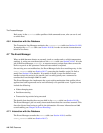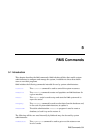The Transaction Log Manager
Configuration information about each partition is held in the partitions table (see
Section 10.2.16). The information is indexed by the name of the partition together with
the name of the active configuration.
4.5 The Switch Network Manager
The Switch Network Manager, swmgr, controls and monitors the Compaq AlphaServer
SC Interconnect (see Appendix A (Compaq AlphaServer SC Interconnect Terms)). It does
this using the switch network control interface connected to the parallel port of the
primary management node. If swmgr detects an error in the switch network, it updates
the status of the switch concerned and generates an event.
swmgr collects fan, power supply and temperature data from the Compaq AlphaServer
SC Interconnect modules, updating status information and generating events if
components fail or temperatures exceed their operating limits. See Section 9.5.4 for
site-specific details of configuring the swmgr.
4.5.1 Interaction with the Database
The Switch Network Manager creates and maintains the entries in the elites table
(see Section 10.2.5) and the switch_boards table (see Section 10.2.22). It maintains
entries in the elans table (see Section 10.2.4). In the event of errors, it creates entries
in the link_errors table (see Section 10.2.11).
4.6 The Transaction Log Manager
The Transaction Log Manager, tlogmgr, executes change of state requests that have
been entered in the transactions table (see Section 10.2.23) by RMS administrative
clients. This mechanism is employed to serialize changes to the database and to provide
an audit trail of such changes.
The entry in the transactions table records who requested the change, and names the
service required together with any arguments to pass to the process on startup. A
transaction handle (a unique ID) is generated for the entry and passed to both the client
and the RMS daemon that provides the service.
The RMS daemon uses the transaction handle to label any results it produces, such as an
entry in the transaction_outputs table (see Section 10.1.3). The client uses the
handle to select the result from the relevant table. Output from the service is appended
to an output log. The name of this log is entered in the transactions table together
with the status of the transaction.
The services that are available are listed in the services table (see Section 10.2.20).
RMS Daemons 4-5


















